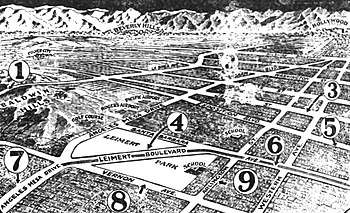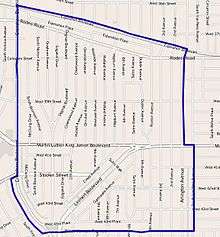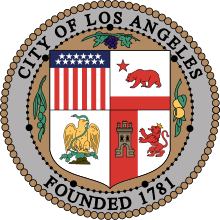Leimert Park, Los Angeles
Leimert Park (/ləˈmɜːrt/; lə-MURT) is a neighborhood in the South Los Angeles region of Los Angeles, California.
Leimert Park | |
|---|---|
Neighborhood of Los Angeles | |
 Leimert Park signage on Leimert Boulevard immediately north of Vernon Avenue | |
 Leimert Park Location within South Los Angeles | |
| Coordinates: 34°00′45″N 118°19′34″W | |
| Country | United States |
| State | California |
| County | Los Angeles |
| City | Los Angeles |
| Time zone | Pacific |
| ZIP Code | 90008 |
| Area code(s) | 323 |
Developed in the 1920s as a mainly residential community, it features Spanish Colonial Revival homes and tree-lined streets. The Life Magazine/Leimert Park House is a Los Angeles Historic Cultural Monument.[1]
The core of Leimert Park is Leimert Park Village, which consists of Leimert Plaza Park, shops on 43rd Street and on Degnan Boulevard,[2] and the Vision Theater. The village has become the center of both historical and contemporary African-American art, music, and culture in Los Angeles.[3]
History

Leimert Park is named for its developer, Walter H. Leimert, who began the subdivision business center project in 1928. He had the master plan designed by the landscape architecture firm of the Olmsted Brothers company which was managed by the sons of Frederick Law Olmsted (1822–1903), the landscape designer known for Central Park in New York City and other major projects.[4] Leimert Park was one of the first comprehensively planned communities in Southern California to be designed for upper and middle-income families. It was considered a model of urban planning for its time: automobile traffic near schools and churches was minimized, utility wires were buried or hidden from view in alleys, and densely planted trees lined its streets. Walter Leimert envisioned a self-sufficient commercial district community, with a town square, movie theater, transportation, and retail shopping. Leimert Park was considered a desirable community, and one of the first to have a Home Owners' Association (HOA).
Elderly Japanese-American residents still live in the area and some of the Japanese gardens still exist. The Crenshaw Square Shopping Center was inspired and designed in the style of Japanese architecture.[5] The center was a hub of retailing in the mid 1950s.[6]
In 2013 and 2014, resurgent home prices in South Los Angeles spurred much interest among many young professionals into moving into Leimert Park and among other areas within the region. Observers took note with mixed feelings: fears of gentrification and hope for increased business investment.[7]
Geography

Neighborhood boundaries
According to LAist: The boundaries are Obama Boulevard (formerly Rodeo Road) on the north, 4th Avenue and Roxton Avenue on the east, West Vernon Avenue on the south, and Crenshaw Boulevard on the west. The Crenshaw District lies to the south, View Park and Baldwin Hills are to the west, Vermont Square is to the east, and Jefferson Park is to the north.[8]
According to the Los Angeles Times Mapping L.A. project: Leimert Park is bounded by Exposition Boulevard on the north, South Van Ness Avenue and Arlington Avenue on the east, West Vernon Avenue on the south, and Victoria Avenue and Crenshaw Boulevard on the west.[9] Jefferson Park is to the north, the Exposition Park neighborhood and Vermont Square are to the east, Hyde Park to the south and View Park-Windsor Hills and Baldwin Hills/Crenshaw to the west. Leimert Park angles to the West Adams district on the northwest.
According to Google Maps: the boundaries are Exposition Boulevard on the north, Western Avenue on the east, West Vernon Avenue on the south, and Crenshaw Boulevard on the west.[10]
According to the books "Leimert Park (Images of America)" and "Los Angeles Residential Architecture", Leimert Park was established with the following boundaries: Martin Luther King, Jr. Blvd. (formerly Santa Barbara Boulevard ) on the north, Arlington on the east, Vernon to the south and Crenshaw Boulevard (formerly Angeles Mesa Drive) on the west.[11][12][13]
Historic Leimert Park Village
Within the Leimert Park neighborhood lies the city-designated "Historic Leimert Park Village". On May 1, 2018, the Los Angeles City Council designated the area between the intersections at Vernon Avenue and Crenshaw Boulevard, 43rd Street and Crenshaw Boulevard, Leimert Boulevard and 43rd Street, Leimert Boulevard and Vernon Avenue, and Degnan Boulevard and 43rd Street as “Historic Leimert Park Village".[14] The Department of Transportation was directed to erect permanent ceremonial sign(s) to this effect at these locations.
In 2005, a "Leimert Park Village" brick gateway marker was installed.[15] [16]
Demographics
A total of 11,782 people lived in Leimert Park according to the 2000 U.S. census— counted 9,880 residents in the 1.19 square-mile neighborhood, about the same as the population density in the city as a whole. The median age was 38, considered old as opposed to the rest of the city. The percentage of residents aged 65 and above was among the county's highest.[9]
Within the neighborhood, African Americans made up 79.6% of the population, with Latinos at 11.4%, Asian 4.9%, white 1.5%, and Other 3.2%. El Salvador and Mexico were the most common places of birth for the 10.7% of the residents who were born abroad. This is a low percentage of foreign-born when compared with the overall city or LA county.[9]
The median household income in 2008 dollars was $45,865, considered average for the city but low for the county. The percentage of households earning $20,000 or less was high, compared to the county at large. The average household size of 2.2 people was low for both the city and the county. Renters occupied 54.1% of the housing units, and homeowners occupied the rest.[9]
In 2000 there were 23 families headed by single parents, or 8.7%, a rate that was low for the city and the county. There were 990 veterans, or 11.1% of the population, considered high when compared with the city overall. The percentage of veterans who served in the Vietnam War was among the county's highest.[9]
Arts and culture
Leimert Park Village
The core of Leimert Park is Leimert Park Village (alternately called Historic Leimert Park Village), which consists of Leimert Plaza Park, two blocks of 43rd Street, and one block of Degnan Boulevard. Leimert Park Village has historically served as a hub of African-American art and culture in Los Angeles, has been compared to both Harlem and Greenwich Village, [17][4] and in 1998 was seen as "the cultural heartbeat of black Los Angeles."[18] The Leimert Park station of the Crenshaw/LAX Line line is under construction.
Vision Theatre
April 21, 2019 marked the 87th anniversary of the opening of the Vision Theatre (initially named the Leimert). This Mediterranean Revival Style theater is at the south end of Leimert Park Village at 3341 West Forty-Third place and Degnan Avenue. It was designed in 1931 by the architectural firm Morgan, Walls & Clements and opened as a movie theater on April 21, 1932.
In 1977 the theater became a Jehovah's Witness Chapel known as the Watchtower. Actress Marla Gibbs bought the theater in 1990 and renamed it the Vision Theatre, intending to make it a venue for African-American movies, live theater, and dance productions. In 1992 the LA civil unrest and an economic recession hit the area hard, and the property fell into foreclosure. The City of Los Angeles acquired the theater in 1999. The Department of Cultural Affairs manages the theater with the goal of providing a performing arts venue for professional performing arts presentations; a training center for talent reflective of South Los Angeles; and a venue for the production and presentation of world-class theater, music, and dance performances.
The first phase of renovations to the Vision Theatre included upgrades to the lobbies, restrooms, office space, and classrooms in 2011. Phase II of the renovation began in March 2018. The rehabilitation of the remaining portions of the theater includes the historic refurbishment and expansion of the theater and auditorium, and the addition of an orchestra pit and a fly loft. The grand reopening of the Vision Theatre is planned for 2021.
The Leimert Park Book Fair
The Leimert Park Book Fair began in 2007 and attracts "more than 200 authors, poets, spoken-word artists, storytellers and other participants."[19]
Destination Crenshaw
Sankofa Park will anchor the northern end of Destination Crenshaw, an open-air museum of African American history and culture that will extend 1.3-miles (2.1 km) down Crenshaw Boulevard through the Hyde Park neighborhood.
Entertainment
The village has blues and jazz night clubs, theaters for musicals, dramatic performances, award ceremonies, comedy specials, and poetry readings, and venues for hip hop. Project Blowed is the longest-running hip hop open mic in the world, started in 1994 by rapper Aceyalone and friends. It is hosted by Kaos Network, and held every Thursday night at 43rd Place and Leimert Boulevard.[20]
Parks and recreation
- Leimert Plaza Park is at 4395 Leimert Boulevard, between Vernon and 43rd Place. The park is unstaffed, with picnic tables, park bathrooms, benches, and a decorative water fountain[21]
- People St Plaza, between the Leimert Plaza Park and the Vision Theater on 43rd Place[22]
- Pocket Park at Degnan Boulevard, Norton Avenue and Edgehill Drive, unnamed[23][24]
Landmarks
- Emmanuel Danish Evangelical Lutheran Church - 4254-4260 3rd Avenue, the church is LA Historic-Cultural Monument No. 578. [25]
- Leimert Plaza - 4395 Leimert Boulevard, designed by the Olmsted Brothers, the park is LA Historic-Cultural Monument No. 620. [26]
- Life Magazine/Leimert Park House - 3892 Olmstead Avenue, the home is LA Historic-Cultural Monument No. 864. [27][28]
Economy
Tavis Smiley, host and producer of National Public Radio (NPR) and the former nationally syndicated talk show Tavis Smiley on PBS, has production studios called The Smiley Group, Inc located within the Leimert Park neighborhood.[29]

The Lucy Florence Coffee House and Cultural Center was established in Leimert Park in early 1996; it hosted an array of talent, art, restaurant and music. Lucy Florence was at 3351 West 43rd Street and Degnan Avenue. It was owned by Richard and Ron Harris, also known as the Aswirl Twins on America's Next Top Model. The coffee house was named after their mother, Lucy Florence, on her 75th birthday; it was then located in the Hollywood neighborhood. In January 2012, Lucy Florence coffee shop closed in Leimert Park.
Another famous jazz venue is 5th Street Dick's Coffee and Jazz Emporium, founded by Richard Fulton in 1992. Fulton died on March 18, 2000. It continues to be a mainstay for jazz music lovers, professional chess players, poets and famous comedians.
Transportation
Crenshaw/LAX Line
In 2014, construction was under way on the Leimert Park station, on the Los Angeles Metro light rail Crenshaw/LAX Line near the intersection of Crenshaw Boulevard and Vernon Avenue.[3] Nearby Leimert Plaza Park was planned to be part of a new walkable corridor with a direct entrance into the station. It would also have new parking structures. A section of 43rd Place would be closed to car traffic and converted to a public plaza.[3][30]
Education
Leimert Park residents aged 25 and older holding a four-year degree amounted to 55.9% of the population in 2000, about average within the city and the county. A high percentage of residents aged 25 and older had a college education.[9]
Leimert Park is served by Los Angeles Unified School District. Within Leimert Park are the following schools:[23][31]
- C.A.T.C.H High School, charter high school, 4120 11th Avenue
- Audubon Middle School, 4120 11th Avenue, LAUSD
- Tom Bradley Global Awareness Magnet, LAUSD alternative, 3875 Dublin Avenue
- New Heights Charter Elementary, 2202 West Martin Luther King Jr. Boulevard (LAUSD)
- Forty-Second Street Elementary, 4231 4th Avenue (LAUSD)
Other schools
- Libertas College Preparatory (on the Tom Bradley campus), 2875 Dublin Avenue (charter)
Notable people
- Mark Bradford, artist known for grid-like abstract paintings combining collage with paints.[32]
- Tom Bradley (1917–1998), Los Angeles mayor[33]
- Busdriver, hip-hop artist[34]
- Ray Charles (1930–2004), singer[35]
- Ella Fitzgerald (1917–1996), singer[35]
- Ras G, record producer and DJ[36]
- Dom Kennedy, rapper[37]
- Carl C. Rasmussen (1901–1952), Los Angeles City Council member[38][39]
See also
- List of districts and neighborhoods in Los Angeles
References
- "Life Magazine/Leimert Park House". historicplacesla.net. Retrieved July 15, 2020.
- "Motion 18-0385" (PDF). LACity.org. Retrieved July 15, 2020.
- Jennings, Angel (February 10, 2014). "Station identification". Los Angeles Times. Archived from the original on March 3, 2015. Retrieved November 23, 2018.
- Lee, Gary (March 19, 2006). "Los Angeles's Black Pride". The Washington Post. Retrieved November 2, 2017.
- Kurashige, Scott (January 30, 2014). "Growing Up Japanese American in Crenshaw and Leimert Park". Departures. KCET. Retrieved November 23, 2018.
- "Crenshaw: a Fresh Start". Los Angeles Times. January 15, 1985. Retrieved August 5, 2020.
- Khouri, Andrew (May 1, 2014). "Soaring home prices spur a resurgence near USC". Los Angeles Times. Retrieved August 3, 2020.
- Thompson, Elise (July 15, 2008). "Neighborhood Project: Leimert Park". LAist.com. Retrieved July 15, 2020.
- "Leimert Park," Mapping L.A., Los Angeles Times
- "Leimert Park as noted on Google Maps". Google Maps. Retrieved July 15, 2020.
- Exum, Cynthia (September 10, 2012). Leimert Park (Images of America). Arcadia Publishing. ISBN 978-0738595870.
- Eversz, Laura (November 2, 2012). "Leimert Park subject of Images of America book". Larchmont Chronicle. Retrieved July 15, 2020.
- Wallach, Ruth (August 31, 2015). Los Angeles Residential Architecture. Arcadia Publishing. p. 66. ISBN 9781625853349.
- "Motion 18-0385" (PDF). LACity.org. Retrieved July 15, 2020.
- "Leimert Park Improvement Project". Los Angeles Neighborhood Initiative. Retrieved August 3, 2020.
- "Neighborhood Project: Leimert Park". Laist.com. Retrieved August 3, 2020.
- "Motion 18-0385" (PDF). LACity.org. Retrieved July 15, 2020.
- Jocelyn Y. Stewart, "A Community's Cultural Heartbeat," Los Angeles Times, October 9, 1998, image 35
- Margaret Wappler, "5 Must-Go L.A. Book Events — From Leimert Park Book Fair to an Ode to Strip Malls," Los Angeles Times, August 23, 2019
- Vigeland, Tess (March 28, 2013). "Neighborhoods: Leimert Park's important place in LA's cultural history )3". Take Two. KPCC. Retrieved November 1, 2017.
- Los Angeles City Department of Recreation and Parks
- Sulaiman, Sahra. "Leimert Park People St Plaza Opens". Streetsblog.org. Retrieved July 15, 2020.
- The Thomas Guide, 2006, page 633
- "unnamed park". google maps. Retrieved July 15, 2020.
- "Emmanuel Danish Evangelical Lutheran Church". HistoricPlacesLA.net. Retrieved July 15, 2020.
- "Leimert Plaza". Historicplacesla.net. Retrieved July 15, 2020.
- "Council File: 07-0299". LACity.org. Retrieved July 15, 2020.
- "Life Magazine/Leimert Park House". historicplacesla.net. Retrieved July 15, 2020.
- "Tavis Talks". tavistalks.com. Archived from the original on May 28, 2017. Retrieved June 5, 2017.
- Reyes, Emily Alpert and Jennings, Angel (December 8, 2014) "Military retailer is Leimert Park's unwelcome neighbor", Los Angeles Times retrieved November 23, 2018
- "Leimert Park Schools," Mapping L.A., Los Angeles Times
- Jackson, Brian Keith (September 20, 2007). "How I Made It: Mark Bradford". New York Magazine. Retrieved August 3, 2020.
- Valerie J. Nelson, "Wife of L.A Mayor Tom Bradley," Los Angeles Times, November 26, 2008
- McNeill, Mark (December 21, 2015). "Resonant Residents: Busdriver & Leimert Park". Ampersand. Retrieved June 9, 2018.
- Gayle Pollard-Terry, "Activism, Music Intersect in Leimert Park," Los Angeles Times, December 25, 2005
- Bell, Max (August 6, 2019). "Spacebase Was The Place: The Life Of Ras G, Blunted Saint Of The L.A. Beat Scene". NPR News. Retrieved August 5, 2020.
- "Interview: Dom Kennedy Talks New Mixtape & Wanting 2Pac To Slap Funkmaster Flex". Complex.
- "Los Angeles Public Library Reference File" (PDF).
- Location of his house on Mapping L.A.
External links
| Wikimedia Commons has media related to Leimert Park, Los Angeles. |
- Leimert Park 20/20 Vision
- Los Angeles Neighborhood Initiative site for Leimert Park project area
- Leimert Park crime map and statistics
- Leimert Park Beat: "The Soul of Los Angeles" is an online community focused on Leimert Park and the surrounding area of South Los Angeles
- LA City Beat: Go to the Park, Leimert Village is a cultural mecca for everyone (19 May 2005)
- Photograph of Leimert Park fountain, 1995

